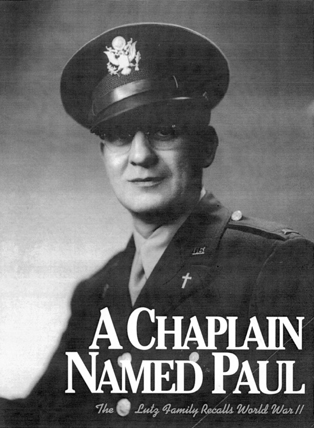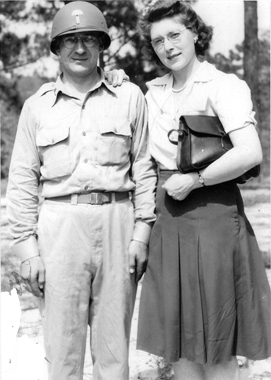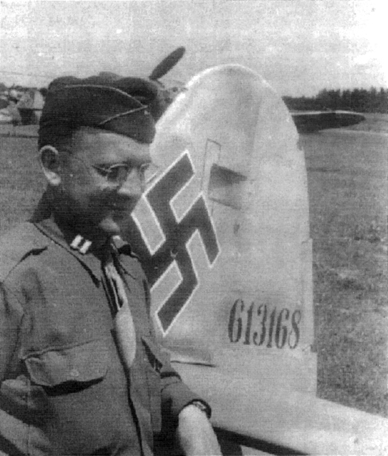|
| Home |
Paul Lutz
1905-1983
A
German-American Chaplain
in the U.S. Army
|
Paul C. Lutz was a
Lutheran pastor in
Lime Springs, Iowa, when the
United Statesentered World War Two. Talk in that town just south of the
Minnesota border, following Congress’ declaration of war on
Germany, included gossip about “the German church.” It was
St. Paul’s Lutheran, where Pastor Lutz had served since 1937. The talk was
not neutral. The harshest words were about the pastor. Some in that
mainly Welsh community called him “pro-German,” even “a
Nazi.” The judgments had no basis in Lutz’s political views.
They resulted from the fact that, as “German church” leader,
Lutz led occasional German-language services. Such services ended
quickly, but rumors remained about Lutz’s lack of patriotism.
Then, in early 1943,
Lutz overheard farmers at the local drugstore gloating over the good
prices the war was producing for their commodities. He told the
farmers it was offensive to hear them gleeful because of a war. They
then accused him of being pro-German.
|

Fifty years after Paul’s enlistment, the Lutz family (Paul’s
widow and six children) published a book of reminiscences from the
World War II period. |
Later that
year, Lutz decided to volunteer for the U.S. Army chaplaincy. Church
leaders were calling for clergy to enlist, and the 38-year-old Lutz felt
he could go. Lutz also said he wanted to show he was a loyal American, and
to silence those who called him pro-German. He later said maybe he had to
prove something to himself, too.
He entered the Army in late 1943, leaving behind a
mother with five young boys. Lutz served Stateside during much of 1944, at
Fort Jackson in Columbia,
South Carolina. In the fall of ‘44 he was shipped toEurope, where he accompanied troops from
Italyto southern
Franceand eventually into German’s
Bavaria, from whence his grandfather Lutz had emigrated to the
U.S.in 1855. Paul Lutz was in southern
Germany from May 1945 until he returned home at Christmas time. Highlights, he
later said, were arranging for
U.S.troops to return the altar and its triptych art work to the Lutheran
church in Geislingen from a cave where they’d been stored for
safekeeping. Another highlight was being regularly recruited, because of
his superb German language skill, to accompany his commanding officer on
visits with local officials.
Lutz also visited the
Dachau
death camp near
Munichand was repulsed by the evidence of Hitler’s Jewish extermination
policies. Once he served Holy Communion to some 500 Hungarians who’d
been conscripted into the Nazi military and were being held as POWs by the
Allies. In German, they said they’d had no pastoral ministry during all
their years in Hitler’s forces. On 29 July 1945
in Geislingen, his 36th Division observed the Chaplain Corps’ 170th
anniversary, and Lutz was featured speaker.
He returned from military
service at the end of 1945, a few months later accepting a call to another
congregation of (mostly) German-Americans, in
Renwick, Iowa. He soon heard stories from his farmer members about the German POWs
who’d worked on their farms. The prisoners came from the POW camp at
nearby Algona, which had closed in February 1946, just prior to Lutz’s
arrival in Northcentral
Iowa. Lutz learned that mutual affection had developed between many of his
German-American members and the POWs who worked on their farms. Lutz said
it warmed his heart to hear it.
|

|
 |
Chaplain Lutz (in uniform) on home
leave at
Maquoketa, Iowa, 1944, prior to departure
for service in Europe. Wife Olga stands next
to him: sons are (from left)
Charles, Lyle,
Fred, Eugene and Curt. |
Chaplain Lutz with wife Olga at Fort
Jackson,
Columbia, South Carolina, in summer of 1944. |
 |
| Paul Lutz at field organ in worship
with U.S. Army troops, somewhere in Germany, spring 1945. |
 |
 |
Paul Lutz posing with a captured Germany
plane, spring 1945. |
Paul Lutz with jeep in Europe, probably early 1945,
while still a 1st lieutenant. |
 |
 |
| In Lime Springs, Iowa, St. Paul's Lutheran was
angrily labeled the "German church" by community persons
in the early 1940s. |
During his two years away from them, Chaplain Lutz's
wife and five boys lived in this home in Maquoketa, Iowa. |
Text
and photos courtesy of Charles Lutz.
| Home |
|

